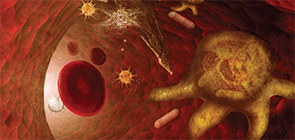
Image Credit: Carol and Mike Werner/sciencesource.com
How the immune system reacts to potential harm, such as lack of oxygen and inflammation, depends greatly on the human body’s metabolic processes and pathways, according to speakers at FOCIS 2015 in San Diego this past June.
During a session devoted to metabolism and the immune system, researchers talked about recent studies that shed light on the body’s response to disease that could lead to a better understanding on prevention and treatment. The discussion began on a high-profile topic of chronic inflammation and a recent discovery of a key protein.
Calorie Restriction
The anti-inflammatory effects of consuming fewer calories appear to be linked to a compound molecule that can inhibit the inflammasome complex that drives some chronic diseases, said Vishwa Deep Dixit, PhD, a professor at Yale University School of Medicine, New Haven, Conn., during a discussion on how calorie restriction influences the immune system.
“When you calorie restrict animals, ranging from a worm all the way up to primates, it’s known that [doing so] substantially reduces the disease burden,” Dr. Dixit said.

Dr. Dixit
Inflammation drives several chronic diseases, such as Alzheimer’s, atherosclerosis and gout. Dr. Dixit outlined studies conducted by Yale School of Medicine researchers that revealed that BHB suppresses activation of the NLRP3 inflammasome in response to the presence of urate crystals, adenosine triphosphate and lipotoxic fatty acids. Such conditions as calorie restriction, fasting and high-intensity exercise prompt the body to produce higher ketone metabolite levels of BHB. Starvation or consumption of a low-carbohydrate ketogenic diet also produces the metabolite, Dr. Dixit said.
Under starvation conditions, the body burns fat, which increases ketones that replace glucose as a source of energy to the brain and other parts of the body. However, Dr. Dixit said it is unknown how these and other metabolic fuels produced during energy deficits exactly influence the innate immune response.
It has been recognized that a starkly reduced intake of calories or fasting tends to diminish inflammation. With this in mind, researchers studying mice and human immune cells looked at how macrophages react to ketone bodies induced by restriction of calories, Dr. Dixit said.
Results from the study showed that BHB blocked the NLRP3 inflammasome by blocking a central adaptor protein needed for inflammation to occur. The significance of the discovery of this compound is that it could be useful in treatments of many inflammatory-driven conditions and diseases, Dr. Dixit said in his closing remarks.
Role of T Cells
The immune system comes into play again when talking about metabolic pathways in cancer and the important job of memory T cells to fight off pathogens., professor of biological sciences at the University of California, San Diego, spoke of her lab’s research on T cell differentiation and immunological memory. Her discussion focused mostly on regulators of the killer T cell immune response.
The fighting force of immunological memory is made up of both B cells and T cells, the latter of which can recognize a pathogen after its first encounter and kill it before it has a chance to wreak havoc on the immune system.
“We’ve been very interested in how protective immunity is formed,” said Dr. Goldrath.
The smallpox vaccine is an important example of immune memory, she said. A majority of people who were given the vaccine retain memory T cells that keep them protected against the highly contagious virus “for their entire lifetime for many individuals,” she noted.

Dr. Goldrath
Dr. Goldrath and her team set out to explore what allows T cells to transition from effector cells to memory cells that can recognize dangerous repeat invaders. In particular, they wanted to figure out “what has to go right” in the process to ensure activation of the preferred immunity response and the signals involved, she said.
“First and foremost, it’s worth noting that immunological memory is mediated by diverse heterogeneous cell populations,” said Dr. Goldrath. “While a lot of people spent a lot of time trying to tease apart what the signals are that will give immunological memory, it appears that this heterogeneous population is relying on a range of signals.”
It’s possible to conduct experiments and predict whether cells will differentiate to short-lived terminal effectors, which clear initial infection and sustain protection for months to come, or instead generate longlived memory CD8+ T cells that have a renewal capacity and can combat second infection. However, cells are in fact integrating all of the signals early on in the activation process, noted Dr. Goldrath.
Because it is known that T cells in the tissue are exposed to hypoxic signals, Dr. Goldrath and her fellow researchers began to explore inhibitory receptors that are regulated by hypoxia inducible factor (HIF), protein that drives gene expression in response to a reduction of oxygen. At the cellular level, HIF’s immune function is to react whenever oxygen drops to critical levels, signaling genes to respond in various ways to combat the effects of hypoxia.
Researchers looked at connections between hypoxia and transcriptional signals that lead to T cell differentiation. There are a variety of signals that are downstream of HIF, with glycolysis often being the most eminent, Dr. Goldrath said.
Sustained HIF helps power glycolytic activity along the metabolic pathway through a series of changes and transformations. Hypoxia-inducible Factors 1 and 2 also contribute to the glycolytic switch observed during T cell expansion, according to Dr. Goldrath.
Elevated HIF activity sustains the killer T cell effector function and notably can also promote memory cell differentiation. This is reflected in CD8+ T cells with high levels of HIF that show sustained effector function but also upregulate key molecules associated with long-lived protective immunity by CD8+ T cells.
In summarizing the research conducted at her UCSD lab, Dr. Goldrath noted that HIF activity enhances the effector function and regulates immune responses that mediate T cells. It also contributes to cell differentiation regulated by metabolism, she said.
Catherine Kolonko is a medical writer based in Oregon.

